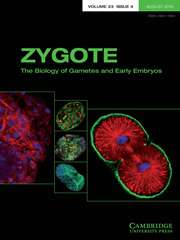No CrossRef data available.
Article contents
Effects of reversine and proTAME treatment on chromosome segregation during mouse oocyte maturation
Published online by Cambridge University Press: 01 September 2025
Summary
Aneuploidy in oocytes is a leading cause of implantation failure, miscarriage and congenital disorders. During meiosis, proper timing of chromosome segregation is regulated by the spindle assembly checkpoint (SAC) and the anaphase-promoting complex/cyclosome (APC/C). However, how pharmacological manipulation of these regulatory pathways affects aneuploidy remains incompletely understood. In this study, we investigated whether SAC inhibition by reversine induces aneuploidy in mouse oocytes and whether partial inhibition of APC/C by proTAME can alleviate these errors. Germinal vesicle (GV) oocytes were matured in vitro in the presence of various concentrations of reversine. To optimize the timing of treatment, oocytes were exposed to reversine for 0, 3, 5 or 7 h, followed by culture with or without proTAME. A proTAME-only group (2.5 nM) was also included. Chromosome spreads were analyzed at the metaphase II (MII) stage to determine aneuploidy rates. Reversine (5 nM) yielded an MII maturation rate of 80.5% but induced a high aneuploidy rate of 77.0%. Sequential treatment with 2.5 nM proTAME significantly reduced aneuploidy to 33.3%. In contrast, proTAME alone led to 79.0% aneuploidy, suggesting its effect is contingent upon prior SAC disruption. These results indicate that reversine compromises chromosomal integrity, while appropriately timed, low-dose proTAME can partially rescue segregation errors. Our findings underscore the potential of pharmacologically regulating APC/C activity to reduce aneuploidy and enhance oocyte quality, offering new avenues for improving outcomes in assisted reproductive technologies.
Information
- Type
- Research Article
- Information
- Copyright
- © The Author(s), 2025. Published by Cambridge University Press


